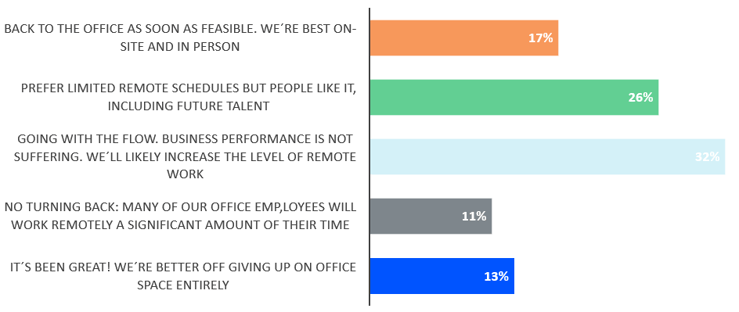TABLE OF CONTENTS

Back to the Office Post Covid-19
Reflections on questions, discussions, and insights from our customers.
How will the habits, limitations, and opportunities we as employees and companies have experienced during the pandemic shape how we work and use our offices?



RETURN TO THE OFFICE
![]() We have seen unprecedented changes in the way we work during the Corona pandemic; many works from home juggling work, family, leisure time, and digital technology have become a premise for collaboration. But what will it look like when we get back to office.
We have seen unprecedented changes in the way we work during the Corona pandemic; many works from home juggling work, family, leisure time, and digital technology have become a premise for collaboration. But what will it look like when we get back to office.
We all look forward to meeting our colleagues at the office again. It has been a topic in numerous interactions with our customers, here we share some of the insights.
Do you prefer video? Enjoy the webinar recording:
How has Covid-19 changed the way we work?
Has COVID-19 changed the way we work or has it accelerated what was already happening? There were already some trends, maybe some of these trends just got a huge boost? The first thing that happened was that we all got to work from home. The office emptied and we learnt to use our home offices, for better and for worse. And that is what happened for almost everyone who had opportunity to do some of their work from a computer.
Collaboration at stake
Just because we had to, in order to run our businesses. Cloud spending increased with 37% during the first quarter of 2020 . Okay. That was a big change. Many companies struggled with that. And some saw all sorts of benefits of remote working. Some didn't have to spend time commuting, resulting in consequently less traveling, less pollution in the cities. You had more flexibility, right?
The upsides of working from home
But also challenges
What do the numbers say?
Increased focus on health and safety.
- A need for getting a documentation, that people are healthy when coming to the office.
- Knowing and reducing capacity of conference rooms
- Potentially wearing face masks.
- increased circulation of air, because that can reduce virus risk.
- Air sensors that can indicate of the risk of virus spreading, by measuring; humidity, CO2 etc.
- Increased focus on how can we make the office more safe despite the pandemic.
HOW WILL OUR OFFICES LOOK LIKE?
We've set our horizon to a post-Covid-19 period and engaged with our customers and researched reports and surveys. We can conclude that many are thinking that it's not going to be like it was before. Much will turn back to normal, but what is it that will change and what are the drivers of this? Why will things not just go back to how they were before?
An interesting fact to mention is that people got used to working remotely and we soon realised we can be just as, and maybe even more, efficient than before. We experienced the benefits, and are now able to see the positive effect it can have on our professional and personal life.
A survey from Price, Waterhouse, Coopers (PWC). Executed amongst 850 US workers and 130 executives managing companies, shows significant interest in a hybrid solution between working in the office and remote work. We shouldn't underestimate the power of the workforce putting up such requirements with the knowledge worker we see today. This needs to be addressed, one way or another.
Many companies who have been open for remote work have seen it didn´t compromise efficiency, and are seeing opportunities for a workforce no longer bound to a geographical location. This results in an increased competitiveness when wanting to attract skilled employees
A survey from JLL amongst 2000 respondents in November 2020, showed 50% of employees wanting some sort of hybrid model where they have the flexibility of both working from home and in the office. 26% prefer only being remote or somewhere else like outside the office and 24% in the office only.
How did the employers respond on the JLL Survey?

With that premise, with those preferences, focus on collaboration and flexibility is paramount. If employees are not in the office all days a week. Why do we go there and how can you create that flexibility of managing a workforce that is not there every day?
A hybrid model catering both remote and in-office work requires considerations:
- Should we have a hoteling solution where you come in and you have certain spaces where you book, desks, book rooms.
- Do we want to share offices? If people are in 50% of the time, would it be possible to share an office with someone else?
- How can we personalize spaces for teams doing certain specific types of work, like projects.
- How can we accommodate the need of making the office more personal?
- Can we benefit from a Café-style seating?
- What about open air conference areas?
- What impact does that have on the interior and architecture of (new) Offices?
Will Activity-based working style become fashionable again?
- Collaborating
- Accessing equipment or documents securely
- Meeting with clients or colleagues
- Training & career development
- Increasing employee productivity
- Providing a space to meet clients
- Enabling employees to collaborate effectively
- Enabling our company culture
But even though that this data shows some different priority and different rankings, there are similarities. It's collaboration, socializing, and it's about meeting clients.
Some things are just required to have a physical presence. Along comes the discussion about, centralizing and decentralizing office space. If we have a flexible workforce and we know we can work remote, why not establish smaller satellite offices to have our workforce avoid commuting? Having that closer to their homes while still getting some place to collaborate and meet in a hybrid workplace.
But does that really fit that need and purpose that we looked at just before? If you are wanting to go there to socialize and meet your colleagues, if you want to go there to learn, if you want to go there to meet clients, is it enough to go to a smaller office where only some of your colleagues are and maybe your clients are not close to. Or is it better to have that central office still where everyone meets if they want to meet?
In the Price, Waterhouse Cooper survey there are both companies thinking about consolidating space while also de-centralizing. And the consolidation topic, especially, is something that we hear across the board and seeing many articles about companies saying we want to lower the amount of real estate. If people are not in the office all the time we don't need as much space. So we're thinking about cutting it down and then having people to share desks. Back to the need for hoteling. Back to the need for sharing spaces, for having flexibility.
Rationally that makes so much sense, but what also comes to my mind is being thoughtful about its effect on collaboration efficiency, but mostly overall employee well-being. What if cutting down on real estate impacts that negatively?
Interesting considerations, which we will be following with interest and write about on our blog. If you are interesting in staying in know, sign-up for the AskCody Blog .
We also recommend you read the JLL article:
REFLECTIONS ON QUESTIONS, DISCUSSIONS AND INSIGHTS
In a recent webinar with some of our customers we opened up the mic for their reflections on how things will look going forward. And here Luke from law-firm Shook shared his view, which we very much would like to share with you;
“We've been an AskCody customer and rolled out AskCody during the pandemic. So we're in a really good spot because everyone is using the tool from home, getting familiar with it.
But one thing I think will happen. And this is from our law firm perspective. We have 15 different offices. A lot of the support where normally we'd fly someone to a place to do a thing will now be done remotely. And I think space is going to get utilized in different ways.
I've been reading so many articles about the office will never return to normal. I think it is going to return to normal. It's just more things happening in less space. And I also think those people that want the flexibility to work from home will be given that flexibility. In our law firm that really wasn't really an option for us.
We had so many things happening in person, but there are certain roles that might make more sense to be remote. And I think that the last point I'd make how this would affect our office space. Specific to AskCody.
One thing we'll be taking a closer look at is what is the space being used for. So instead of having a floor of 20 conference rooms and it's just meetings, and I think it will help us prioritize how that space is used and make better decisions going forward.”
That resonates very well and we think Luke is onto something there. We see customers considering optimizing the use of space, while still being able to execute the same variety of things as before, but more efficient and with an increased focus on Health and Safety.
READ THESE ARTICLES ON THE TOPIC
- BLOG: The Future of Workspace Through the Eyes of the Employees
- BLOG: Tips for Desk & Meeting Room Booking During the Pandemic
- BLOG: 9 Tips on How to Make Your Office Corona Compliant
- BLOG: Transitioning to hybrid working post-Covid
- PODCAST; What will “normal” look like post-COVID?
- REPORT: 2021 real estate vision report by JLL
- Case Study: Implementing AskCody Meeting Management during COVID-19
- WEBINAR: 10 Tips to Make Your Office COVID-19 Compliant
- 9 Must-reads when prepping your office return in 2021




